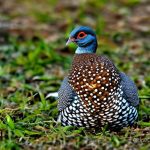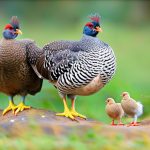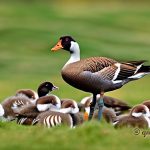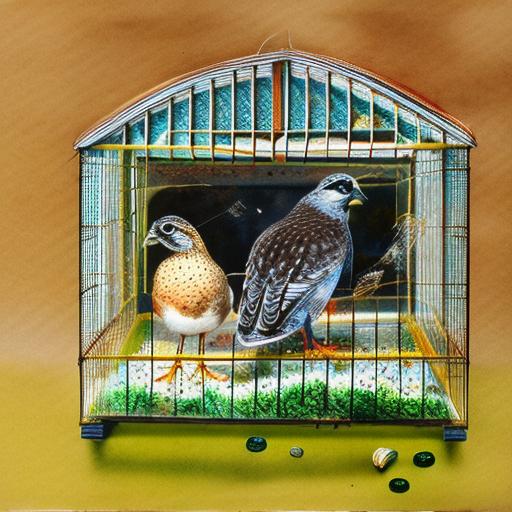As a quail keeper, you might find yourself pondering whether these petite birds embrace the art of brooding over their eggs as chickens do. It’s a common curiosity among those who are new to the avian breeding scene or even seasoned enthusiasts looking for confirmation on best practices.
Perhaps you’ve peered into the nesting area after your flock has laid their speckled treasures, only to notice an apparent lack of interest from your feathered friends—sparking concern about the fate of those unhatched gems.
In my own experience with these charming creatures, and after delving into quite a bit of research, I’m here to put your mind at ease. Indeed, some quail species have motherly instincts that kick in given ideal circumstances.
Take Coturnix quail for example—they’re known to diligently settle onto their nests once they’ve completed their clutch. In this guide, we’ll navigate together through the ins and outs necessary for successful hatching—from recognizing when your quails are getting broody to crafting an optimal incubation haven.
Get ready to hatch a plan filled with knowledge—you might just be surprised by what these little dynamos can do!
The Natural Incubation Process for Quails
When quails are ready to lay eggs, they will seek out a secure nesting area and begin the process of mating and egg laying. After laying their eggs, the female quail will build a nest and enter the incubation period to hatch their chicks.
Preparing a secure nesting area
I know how important it is for quail keepers to have a secure nesting area for their birds. I make sure my quails feel safe and comfortable to lay and incubate their eggs successfully.
- Choose a quiet location in the coop where there’s little foot traffic. Quails get stressed by noise and movement.
- Make the nest with soft materials like straw or wood shavings. This gives comfort and keeps eggs warm.
- Provide enough space for the quail to move around but ensure it’s cozy. A cramped space can make them nervous.
- Keep predators away by securing the coop with mesh wire or fencing. Safety from predators means relaxed quails.
- Set up the area away from feeders and water containers. It helps prevent messes in the nest.
- Ensure proper lighting, not too bright but just enough that they don’t sit in darkness.
- Maintain stable temperature control within 99.5°F if possible, especially during colder months.
- Add a roof over the nesting area to mimic a natural cover, making them feel hidden and secure.
Mating and egg laying
Quails mate throughout the year, with a peak in spring and early summer. After mating, a quail will begin laying its eggs within 24 to 48 hours. The female quail can lay up to one egg per day, typically in the late afternoon or early evening.
Once nesting begins, it is vital to provide a secure area for them to lay their eggs undisturbed.
To encourage successful egg production and hatching, ensure that your quails have access to a nutritious diet containing sufficient calcium. A consistent supply of clean water is essential for healthy egg production and overall well-being.
Nest building
Quails construct cozy nests on the ground, utilizing grass, leaves, and other natural materials. They weave these items together to form a secure and warm environment for their eggs.
Temperature control is crucial during nesting; quails are meticulous in selecting sheltered areas to ensure the incubation process proceeds smoothly.
During nest building, quails exhibit impressive attention to detail, using their beaks and feet to meticulously arrange the nesting material. Once completed, these well-constructed nests serve as protective havens for the precious eggs awaiting incubation.
Incubation period
Quail eggs have a relatively short incubation period of 17-18 days, requiring a consistent temperature of 99.5°F for successful hatching. It’s important to turn the eggs at least four times daily during this time to ensure proper development.
While Japanese (Coturnix) quail eggs can take up to 21-22 days to hatch, patience is key during the incubation process.
For successful hatching, maintaining proper temperature and humidity levels is crucial throughout the entire 17-18 day period. Turning quail eggs several times a day ensures healthy development and increases the likelihood of successful hatching.
Signs of A Broody Quail
You’ll notice changes in their behavior, feather loss, and hormonal shifts when quails are ready to sit on their eggs. To learn more about these signs and how to encourage your quails to incubate their eggs, keep reading!
Behavioral changes
During incubation, quails undergo noticeable behavioral changes. They become more protective and may spend extended periods sitting on their eggs. Some may also show signs of aggression or agitation when approached, as they are focused on the task at hand.
Another common behavior change is a decrease in overall activity; broody quails tend to remain close to their nesting area, often forgoing regular feeding and socializing with other flock members.
Additionally, broody quails might pluck feathers from their chest to create a warmer environment for the eggs. This act exposes the skin, allowing better heat transfer to the eggs during incubation.
Feather loss
During the incubation period, quails may experience feather loss around their breast area. This is an important sign indicating that the quail is broody and preparing for egg incubation.
The hormonal changes trigger this behavior as they create a warm environment for the eggs using their bare skin to ensure successful hatching. Providing them with a calm and secure nesting space during this time is crucial, while minimizing disturbances helps in promoting successful incubation.
Moving on from understanding the signs of a broody quail, let’s delve into the specific behavioral changes that can signal your quail’s readiness to sit on her eggs.
Hormonal changes
As the quail prepares to incubate her eggs, her body undergoes hormonal changes that trigger brooding behavior. These changes lead to increased territoriality and aggression to protect the nesting area and future chicks.
The hormone prolactin also rises, inducing maternal behavior such as staying on the nest for extended periods and carefully tending to the eggs by adjusting their position. These hormonal shifts are vital for successful egg incubation and early chick care.
Maintaining a stable environment during this period is essential due to these hormonal changes. It’s important not to disturb the quail unnecessarily as it may disrupt these crucial processes.
Tips for Encouraging Quail to Incubate Their Eggs
– Providing a quiet and calm environment is essential for encouraging quail to incubate their eggs. Ensuring proper nutrition and space, as well as avoiding disturbing the nesting area, are also crucial factors in promoting successful incubation.
Provide a quiet and calm environment
To encourage quails to incubate their eggs, I ensure a quiet and calm environment. This involves minimizing disturbances near the nesting area. It’s important to keep loud noises and sudden movements away from the quails during this crucial time.
Maintaining a serene atmosphere helps in creating an ideal setting for natural incubation process as it reduces stress on the broody quail. Disturbing the nesting area can lead to abandonment of the eggs or decreased egg viability, which is critical during the short 17-18 day incubation period for quail eggs.
By providing a peaceful environment, I support my quails in successfully hatching their eggs within the required timeframe and maximizing hatch rates.
Ensure proper nutrition and space
Creating a conducive environment for successful quail incubation isn’t just about providing peace and quiet. Ensuring the availability of proper nutrition and ample space is vital too.
A balanced diet rich in protein, vitamins, and minerals promotes healthy egg production and overall well-being for your quails. Additionally, sufficient space allows them to move comfortably, reducing stress and promoting natural incubation behaviors.
Maintaining ideal nutritional intake ensures that your quails have the essential resources to lay good quality eggs while also supporting their physical health during the demanding incubation period.
Avoid disturbing the nesting area
Ensure the nesting area remains calm and quiet to avoid stressing the brooding quail. Quails need peace and privacy during incubation, so limit human or predator disturbance. Maintaining a tranquil environment supports successful hatching and chick rearing without unnecessary disruptions.
Moving on to “FAQs About Quail Incubation”..
FAQs About Quail Incubation
– When do quails start laying eggs and how often do they lay them?
– How long do quails sit on their eggs to hatch them?
– What are some reasons why my quails may not be laying eggs?
When do quails start laying eggs?
Quails typically start laying eggs at around 6-7 weeks old. It’s best to wait until they are at least 50 days old before expecting consistent egg production. The amount of daylight and nutrition provided can also influence when quails begin to lay, so ensuring a balanced diet and proper lighting is essential for optimal egg-laying.
Keep in mind that stressors such as overcrowding or sudden changes in their environment can delay the onset of egg production.
Understanding when quails start laying eggs is crucial for planning and ensuring the right conditions are in place for a successful hatching process later on. By providing an ideal environment, nutrition, and monitoring their well-being, you can encourage healthy egg production from your quail flock.
How often do quails lay eggs?
Quails lay eggs nearly every day, with a peak egg-laying period occurring during the spring and summer months. A healthy quail can produce up to 200 eggs per year, provided they have access to proper nutrition, space, and lighting conditions.
It’s essential to promptly collect fresh eggs daily and store them in a cool place for optimal hatchability.
Consistency in egg collection is crucial as quails tend to be prolific layers throughout their prime laying seasons maintaining good health and minimizing stressors contribute significantly to sustaining consistent egg production.
How long do quails sit on their eggs?
Quails usually sit on their eggs for an average of 18 days before they hatch. The incubation period can slightly vary, ranging from 16 to 20 days. It’s important to maintain a consistent temperature and humidity during this time for successful hatching.
Turning the eggs multiple times a day is also crucial for proper development, ensuring that all parts of the egg receive equal warmth.
During the incubation process, it’s vital to keep track of time and maintain optimal conditions to support healthy chick development. Proper care during this period will help in raising strong and vibrant quail chicks.
Why are my quails not laying eggs?
My quails might not be laying eggs due to improper lighting in their environment. They need around 14-16 hours of light daily to stimulate egg production, so adjusting the lighting duration could encourage them to lay.
Additionally, ensuring that my quails have a balanced diet with adequate calcium is essential for healthy egg-laying. Calcium deficiencies can lead to decreased egg production or thin-shelled eggs, impacting their ability to lay consistently.
Monitoring their nutrition and providing proper supplements can help address this issue.
Creating a stress-free environment for my quails is crucial as stress can hinder egg-laying. Anything from overcrowding to predator disturbances can cause stress, disrupting their laying cycle.
Conclusion and Recap.
In conclusion, mastering the art of quail incubation is crucial for a successful hatching process. Implementing brooding techniques and maintaining optimal temperature levels are vital.
Have you considered creating a secure nesting area for your quails to encourage natural incubation? Explore further resources on raising quail chicks and enhancing parental care for an enriched experience.
The impact of proper incubation methods can lead to sustained meat and egg supply for your homestead. Reflect on these strategies as you embark on your journey in quail breeding and hatching.
FAQs
1. Do quails sit on their eggs to hatch them?
Yes, quails do sit on their eggs to hatch them. This natural hatching process is part of their nesting behavior and parental care.
2. Can you use an incubator for quail eggs?
Absolutely! You can use an incubator designed for quail eggs to control the incubation temperature and help in hatching quail chicks successfully.
3. What’s important about turning Coturnix quail eggs while incubating?
Turning Coturnix quail eggs during the incubation period helps prevent the embryos from sticking to the shell, which is crucial for successful hatching.
4. How long does it take for a quail egg to hatch?
The typical duration of a full quail egg hatching process is about 17-23 days depending on the species like Coturnix.
5. What should I do after my quails’ eggs have hatched?
After your baby chicks have arrived, brooding Quail chicks involves keeping them warm and safe as they grow stronger every day.
Meet Walter, the feathered-friend fanatic of Florida! Nestled in the sunshine state, Walter struts through life with his feathered companions, clucking his way to happiness. With a coop that’s fancier than a five-star hotel, he’s the Don Juan of the chicken world. When he’s not teaching his hens to do the cha-cha, you’ll find him in a heated debate with his prized rooster, Sir Clucks-a-Lot. Walter’s poultry passion is no yolk; he’s the sunny-side-up guy you never knew you needed in your flock of friends!








25 days ago, I noticed 8 eggs in a large geranium pot. The next day there were 11 eggs in the pot. I have watched a daily that a quail sits on the eggs. She leaves every day between 5 and 7:00 PM, retruning to sit once again. I am beginning to wonder if the eggs are ever going to hatch and if not what will the hen eventually do?
Hey Barbara
Quail eggs usually take around 17-20 days to hatch. I have had some that have gone on to 22 or so days. Do you have males? The eggs may not be fertilised, or may have gone bad depending on how cold it is in your area.
I take the eggs away from my girls when I see them (ones that are with males) and then incubate inside to keep perfect temps etc.
I would suggest maybe cracking one open, as it has been too long now.
Let me know how you go!